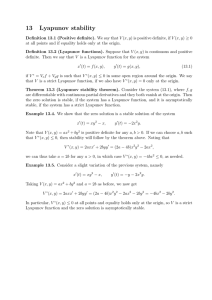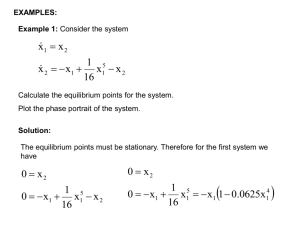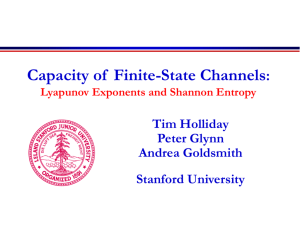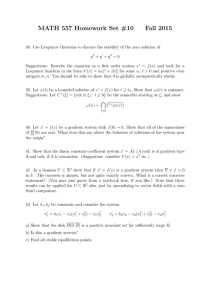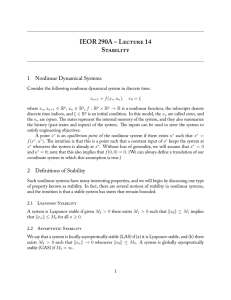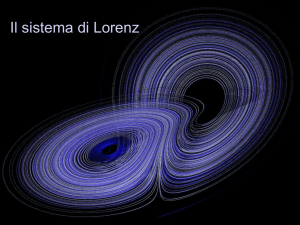’ ANALYSIS STABILITY PROBLEMS VIA MATRJX LYAPUNOV FUNCTIONS
advertisement
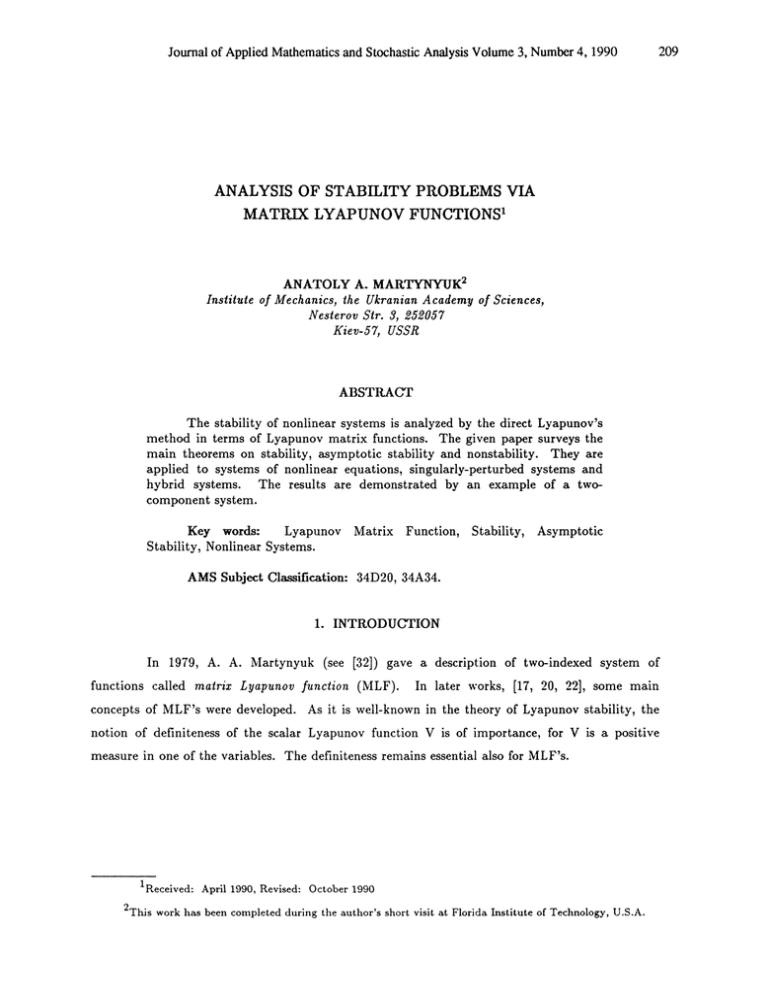
Journal of Applied Mathematics and Stochastic Analysis Volume 3, Number 4, 1990
209
ANALYSIS OF STABILITY PROBLEMS VIA
MATRJX LYAPUNOV FUNCTIONS ’
ANATOLY A. MARTYflIK2
Institute
of Mechanics,
the Ukranian Academy
of Sciences,
Nesterov Sir. 3, 252057
Kiev-5% USSR
ABSTRACT
The stability of nonlinear systems is analyzed by the direct Lyapunov’s
method in terms of Lyapunov matrix functions. The given paper surveys the
main theorems on stability, asymptotic stability and nonstability. They are
applied to systems of nonlinear equations, singularly-perturbed systems and
hybrid systems. The results are demonstrated by an example of a twocomponent system.
Key words:
Lyapunov Matrix Function, Stability, Asymptotic
Stability, Nonlinear Systems.
AMS Subject Classification: 34D20, 34A34.
1. INTRODUION
In 1979, A. A. Martynyuk (see [32]) gave a description of two-indexed system of
functions called matriz Lyapunov function (MLF). In later works, [17, 20, 22], some main
concepts of MLF’s were developed. As it is well-known in the theory of Lyapunov stability, the
notion of definiteness of the scalar Lyapunov function V is of importance, for V is a positive
measure in one of the variables. The definiteness remains essential also for MLF’s.
1Received: April 1990, Revised: October 1990
2This work has been completed during the author’s short visit at Florida Institute of Technology, U.S.A.
Journal of Applied Mathematics and Stochastic Analysis Volume 3, Number 4, 1990
210
2. THE DEFINITENESS OF MATRIX-FUNCTIONS
Let (R n,
an open ball centered at the origin with radius p; let
Moreover,
=[--oo,+o] and B(p).
D-=R x B(p) be the Cartesian product of
we shall consider an open connected time-invariant
neighborhood N C_ n of point z-=--0 and intervals To={t: o _< < +oo}, t o E T, T C_ R and
Tv={t" v _< t < +oo), r E where T is the set of initial values.
,
Consider a perturbed motion equation
-tz---=f(t, x), f(t, 0)=0,
(2.1)
where z fi Rn and f
Suppose that
a solution
X(i; t0, z0) of (2.1) is continuous for all t fi TO and
X( o; to,
Since the definitions of stability of the trivial solution of
(2.1)
with respect to
attraction with respect to T and asymptotic stability with respect to T are given in
same concepts relative to a part of variables are introduced in
Matrix-Function (MF). Together
with
(2.1)
[16],
T,
[5, 7], and the
we omit this notions here.
we consider a two-indexed system of
functions
U(t, x)=(uij(t z)), i, j {1, ..., m},
rn
>
(2.2)
1
C( Tr x B(p), gO).
with uij
The notion of the definiteness of an auxiliary function (that is used in the direct
Lyapunov’s method) is a main one [15], since this behaves as a scalar function having all norm
properties.
..
The definiteness of the MF can be defined in terms of the definiteness of a
corresponding scalar function whose construction is based on the MF.
1
2
By means of the matrix-function U,
we can introduce the following scalar functions
Uo(t, x)=maz{ uij (t, z)" 1 <_ i, j <_ m};
Uo(t, z)=T U(t, z), where E IR’ or E C[ n, ], (0)=0;
u0( ,
rn
E
i, j=l
Matrix-function U: T r x R nNm x m is called
positive definite on Tr iff there exists a time-invariant connected neighborhood N C_ N n
Definition 2.1.
1)
,
of point z=-O, a positive definite function, w:
a vector-function
u= C(T
N--,N+, and a vector
C[N t], (0)=0 such that
m
N+ or
Analysis of Stability Problems Via Matrix Lyapunov Functions: Martynyuk
b)
c)
2)
3)
211
, ,
U(t, 0)=0 VtE
Uo(t, x), defined by 1 20 and 3 satisfies the condition
Uo(I x) > w(x) V(/, x # 0) e Tr x R n.
positive definite on Tv x S iff the above conditions a) c) are satisfied for
N=S (where S R n is an arbitrary set);
positive definite in the whole on Tv iff the conditions a) c) are satisfied for
function
N=R n;
4)
negative definite (in the whole) on Tr x N (on
definite (in the whole) on Tr x N (on Tr).
.
r"
The expression "on T
Remark 1
requirements are satisfied for every r
Tr) iff (- is pitive
in Definition 2.1 will be dropped if all above
the (i, j)-th element uij" RnR does not depend on tfi
conditions of Definition 2.1 are simplified, in particular, condition 1 c) is reduced to
Remark. 2 If
Tr,
the
U’0( > 0 V(x 0) en, ( 0) e
Remark 3 The
definition of the semidefiniteness of the MF is formulated via
Definition 2.1 and Definition 10 from
[7, p. 23].
Remark 4 In the case when m=l and Tr=R Definition 2.1 is reduced to the original
definitions of positive semidefiniteness (in the whole) introduced earlier by Lyapunov [15] and
Barbashin/Krassovsky [11].
Matrix-function U: Tr x R n--,m x m is called
,
Defitdtion 2.2.
1)
decreasing on
z’=O,
TT.
7"
a positive definite function u:
conditions 1
N--,, and a vector
a) and 1 b) of Definition 2.1
v0(t,
3)
iff there exist a time-invariant neighborhood N C_ n of point
<
[+m such tha the
are satisfied and
v(, # o)e
e
decreasing on Tr x S, iff the above conditions 1) hold for N=S (S C_
decreasing in the whole on Tr if the conditions of 1) hold for N=Ii n.
3. MATRJX LYAPUNOV FUNCTION
First observe that the definiteness of MF’s
called "maximum function" introduced
[17] was based on a generalization of the soby LaSalle [14] for the case of vector functions. Later [18,
30], the concept of the definiteness has been modified, however
no formal definition was
introduced. We now introduce the definition of MLF’s based on the definiteness of the MF from
212
Journal of Applied Mathematics and Stochastic Analysis Volume 3, Number 4, 1990
(whose special case agrees with the classical definiteness via Lyapunov [15]
(of., [11, 12, 381).
We define the total derivatives of the matrix-function (2.2) by virtue of system (2.1)
Section 2
D+ U(I,z )=(D+ uij (t, ); i, j e { 1,..., m}),
as
(3.1)
where
D+uij(t, z)=lim suPtuij(t+O
D+ U(t, x)=(e+uij(t
z+Of(t,z ))-uij(t,
z)]o-l:o---,O+};
); i, j e {1, ..., m}),
(3.2)
where
Unless specified,
D+uij(t z)=lim in]([uij(t+O z+O](t, z))-uij(t,
D’U is either D+ U(t, z)or D+ U(t, x).
Definition 3.1.
C)]o--l:o-’*Oq’}.
The two-indexed system of functions (2.2) is called a matrix
Lyapunov function for system (2.1) if on Tv N
the function U is definite;
a)
D* U is semidefinite and has either the same sign as U or the opposite sign of U.
b)
It is clear that the function U (cf. (2.2)) and it’s total derivative in terms of (2.1) solves
the stability problem of state z’=0 of equation (2.1).
Definition 3.1 can be specified for various dynamic properties of state z’-=-0. Denote S()
the set of MLF’s that solve the stability problem.
Definition 3.2.
A MF U:
TrxRn-R mx is called
a
MLF of S()- type
on
Trx Nif
1)
U is positive definite (decreasing),
D + U is nonpositive definite and D + U(t, 0)=0 Vte Tr.
Let AS(C) be the set of MLF solving the problem of asymptotic stability of state x=-0.
Definition 3.3.
A MF U:
TrxRnRmXm is called a MLF of AS()-type on
Trx Nif
1)
2)
U is positive definite (decreasing),
D+ U is negative definite and
D+U(t, 0)=0
Vie Tr.
Let NS() be the set of MF’s solving the problem of instability of state
Analysis of Stability Problems Via Matrix Lyapunov Functions: Ma_rtynyuk
Definition 3.4.
NS(ff)-type if there exist
such that on TO x W
a
213
A MF U: Tr Rn._,Rm m is called a Lyapunov-Chetayev MF of
o E T, a A > 0, such that ( A C N and an open set W C B( A
U(t, z) < (7, where C is an m x m real-valued matrix;
tTD+ U(t, z)$ > a(v(t, z, )), a is an element of Hahn class K
0<
b)
)
d)
ocow;
U=O on
To x (O Wfq B(
)).
4. THEOREMS OF DIRECT LYAPUNOV METHOD IN TERMS OF MATPAX-FUNGIONS3
The meaning of the introduced definition of MLF’s is revealed in view of the following
classical results of stability theory of motion.
In order that the trivial solution of the equation (.1) to be
(uniformly) stable, it is necessary and sufficient that for (e.1) there exists a MLF
U: Tv rt...,rn x m of S()-type for any positive integer m.
Theorem 4.1.
Theorem 4.2.
of the equation (.1) to be
sufficient that for (e.1) there exists a MLF
in order that the trivial solution
(uniformly) asymptotically stable, it is necessary and
U: Tr n...m m of AS()-type for any positive integer m.
In order that the trivial solution of the equation (.I) be unstable it
is necessary and sufficient that for (.1) there exists a Lyapunov-Chetayev MF
U’: T7. x n...,m x m of NS()-type for any positive integer m.
Theorem 4.3.
R.eark 5
For m=l Theorems 4.1 4.3 are reduced to the classical results on
stability, asymptotic stability and non-stability obtained in ([11, 12, 38]). For autonomous
systems results similar to Theorems 4.1 and 4.2 are given in [6], in terms of the MF (2.2) with a
given vector
b(b O, i=1, ..., m) (see Remark 2).
5. METHODS OF CONSTRUCTION OF MLFs
We consider time-invariant nonlinear system
3The proofs to Theorem 4.1-4.3 are not yet published and are contained in a monograph by the author
that will appear later.
214
Journal of Applied Mathematics and Stochastic Analysis Volume 3, Number 4, 1990
--=f(z),
where z E R n and
f E C(R n, R n)
(5.1)
is subject to physical or mathematical decomposition into m
interconnected subsystems
t=gi(xi)+hi(x)A=fi(x), i=1, 2,...,
Here x E
hi,
z"-----(xlT,
xTm)T, f=(, f2T
T
x2
fTm)T,
(5.2)
m.
E
, tO=O.
The free subsystems
corresponding to the system (5.2), contain the main information on dynamic properties of the
system (5.2):
t=gi(xi),
E
{I, ..., m}
Assumption 5.1..._ There exist open connected neighborhoods N of states
Vi
{1, ..., m}
a)
motions
(5.3)
xi=O
such that
xi(t Xio of subsystems (5.3) are continuous on
R+ x N and zi(0
Zio)=O
Vi E
{1, ..., m};
z(i, x0) of system (5.1) is continuous on E R+ x N, where N=N1 x...N,n
and z(0, x0)=0.
The decomposition of system (5.1) into interconnected subsystems (5.2) is called the first level
b)
motion
decomposition, which corresponds to the following approach of the construction of the MLF.
In matrix function (2.2) the diagonal elements vii(x), are subject to the dynamical
(5.3) and the non-diagonal elements vij(xi, zj) are constructed
interconnections hi(x), Vi,j {1, ..., m}. Therefore, the MLF for the system
properties of the free subsystems
in response with
(5.2) has the form
Vll(Xl) Vl2(Xl 2)’ "’" Vlm(Xl’ Xm)
=
Vml(Xm’ Xl) Vm2(Xm’ 2), "’" Vmm(Xm)
The definiteness of this MLF is defined according to Definitions 2.1 and 2.2 and Remark 2.
It is possible by the construction of a vector-function to implement the interconnections
hi, i=1,..., m. ttowever, even in this case, the use of a MF improves the estimate of the region of
Analysis of Stability Problems Via Matrix Lyapunov Functions: Martynyuk
asymptotic stability
[cf., 36].
Example 1_.
z
215
(:T’ zT2)T’ where x
(See [3]). Let x E R n and let system (5.1) be
E hi, "1 +n: = n, we have
A12
A22
All
A21
d__.z =
dt
linear. Then, setting
The elements of the matrix U are taken in form
for i, j= 1, 2. For the function
v(x,
I)=r/T U(x)r/, r/( !2
(5.5)
r
we obtain the estimate
v( x, 7 ) >_ uT BT CB u,
where
B=diag(l,
Cii=)min D ii)
Cij=-sign(rli, yj),
/2 D DT
max,.ijij,, i, j= 1, 2.
Obtaining the total derivative of the function v in (5.5) by virtue of system
t =Aiixi+
Aijxj,
i=1
it is easy to get the upper bound
Dv(z, rl) <_ uTQu,
(5.8)
where Q is a 2x e-matrix constructed in terms of certain estimates of the derivatives of the
T,
components of the ME U [cf. 2, 28]. The stability conditions for the state (x x2"2) T =0 of system
(5.7) are formulated by means of the definiteness of the matrices A and Q.
For an autonomous nonlinear large scale system (LSS) an algorithm for construction of
.
(ASD) is developed by means of a MLF (see [9]). The algorithm
is as follows. Consider a class of MF’s, whose m x m elements are positive definite forms. A class
of scalar functions (SF) is also, constructed based on the class of MLF’s as a subclass of MF’s, i.e.
for U (x, Bij ) MF, Bij=B > 0 the function
estimate of asymptotic stability
v(x,
o
r
Bij)=T U(z, Bij)rl, rl e R s
Journal of Applied Mathematics and Stochastic Analysis Volume 3, Number 4, 1990
216
O
+
x=S is a space of admissible parameters. Given
(7, Bij)E
matrix-function U(z, Bij MF, the estimate of the ASD of LSS
is constructed, where
$
={, e a". (,,
0,
B) < (, B)}
is made such that
Dv(:r.,
rl,
Bij)=yTDu(x, Bij)r < 0
V(x # O)
and
I.t(rl, Bij)=min v(x,
The hypervolume of the set
in
1,
Bij),
n is taken as its measure, and the problem of ASD extension is
reduced to the problem of the conditional maximization.
Remark 6
In the MF (5.4) the diagonal elements vii(xi)
are constructed in
order to satisfy the inequalities
;;;( I ; !!) _< v.(;) < "ffiii !1 i I! ),
where ii, "ii
inequalities
> O, i, i K
are of Hahn class
i=1, 2,
..., m,
K(KIR), and nondiagonal elements satisfy the
(5.10)
where -ij, -ij =cns, (i # j) {1,...,m}.
Another way of a MF construction for system
considered pairs
(5.1) appeared
in
[21] where there
were
(i, j), (i-- j) e { 1,..., m} of the interconnected subsystems
dx
--=qi(xi, xj);
(5.11)
NnJ
n:
where qi Nni x Nnj--[ni; qj:
X ni---, ", qi(O, O)=qj(O, 0)=0 for all i, j e {I,..., m}.
Such a decomposition is naturally referred as the second level decomposition, and the MF here
is regarded as a hierarchical one
[27, 9]. The MF elements
U(z)=(vij )),
are defined as
i, j e
{1, ..., m}
Analysis of Stability Problems Via Matrix Lyapunov Functions: Martynyuk
217
vii(Xi) for
vij(xij
vi5=
The functions
< j;
() fo > j, (i # j) e {,...,m}.
vii nixnj, R] correspond to the (i, j)- pairs
assumptions on the functions
interconnected system
obtained
for
of
Vii and their total Dini derivatives by virtue
(5.11). Under some
of systems (5.11) and
(5.1), sufficient conditions for stability of equilibrium state x=-0
are
(see [9, 21]).
6. MATKIX-FUNC’IONS FOR SINGULARLY-PERTURBED SYSTEMS
It is known that systems of the type
where
(xT, yT)TE m+n,
pE
dx/dt=f(t, :r,, y),
(6.1)
pdy/dt=g(t, x, y, p),
(6.2)
[0, 1] and
and g are vector-functions continuous in all their
arguments, are of a considerable importance for applications. This is the most general example of
In [19, 33], it was proposed to use the
systems admitting the motion separations for p0.
matrix-function
V21(/,
X, y,
].t),
V22(t
y,
for solving the problem on stability of equilibrium of state x=0 in the equations
(6.1), (6.2).
We consider two concrete classes of systems (6.1), (6.2) and matrix-functions corresponding to
them.
CASE A.
where
A11...A12
Linear singularly-perturbed system has the form
dx/dt=A11x+A12Y,
(6.4)
l.tdy/dt= A21xW A22 Y,
(.5)
are constant matrices of the corresponding dimensions.
elements of matrix-function
(6.3)
are taken in the form
v12( x, Y, #)=v21(x, Y, I.t)=pxTB3Y,
For convenience, the
Journal of Applied Mathematics and Stochastic Analysis Volume 3, Number 4, 1990
218
where matrices
B1, B2
are symmetric positive-definite and
B3 is
a constant matrix, similarly to
the conditions from Example 1, for various types of stability of state z-=-0 of
obtained by means of functions of the type of (5.5) for ] E
(6.4), (6.5)
were
(
(0, #0] and for/---,0, (see [34]).
7. STABILITY OF IIYBRID SYSTEMS
The problems of hybrid system stability in sense of Lyapunov are of essential interest both in
theoretical and application aspects. Recently a problem of hybrid system practical stability has
(see [20, 25]). The hybrid interconnected system (HIS) is a model of a really
functioning system, a part of which is usually described by a (not necessarily linear) operator L
and the rest of which is described by a system of ordinary differential equations (ODE’s). In
also been considered
many cases, the operator/, describes the object and the system of ODE’s describes the regulator.
In general, the operator L may represent either finite-dimensional system ODE’s, infinitedimensional system, delay equations, partial differential equations, Volterra integral equations or
integro-differential equations. For the systems constructed by the operator L, are introduced the
Banach space E =
YI Ei
is introduced, where E are Banach spaces corresponding to the
i=1
subsystems
(o’k. gk),k {1, ..., m}
with norms
the k-th interconnection function, the pair
O"
k
-
I1" ]1 k"
(o.k, gk)
Here o’k is
a free k-th subsystem, gk is
determines the k-th interconnected subsystem
To be specific, we suppose that the HIS consists of isolated subsystems
o.i:
where
Xi: T r x Ei---,E
dxi Xi(t, zi), Xi(t,0) = 0,i
1,2,...,m,
are connected by interconnection functions
gi: gi-
...
gi(t’Xl,’",Xm), e {1,...,m}
x Em---,E i.
and such that gi: Tv E1
The fixed interacting k-th subsystem is described by the pair
dx k
W=
where x k
+
(7.2)
(7.3)
E k. We introduce some assumptions.
Assumption 7.1.
Vi
(7.1)
There exist connected neighborhoods NiC_Ei of states zi =0
= 1,2,..., m such that
zi(t, to, zi) of subsystems (7.1) are continuous on (t, xio
where z(0; to, Xio = 0, = 1,2,...,m;
the motions
TrXN
219
Analysis of Stability Problems Via Matrix Lyapunov Functions: Martynyuk
to, z0) of HIS is continuous on (/,Xo) E r r x N, where
N = N 1 x N 2 x... x N m and z(0; to, :o)= 0.
Let U E C[TrxE, R mxm] be a MF for system (7.3). Like the functions Uo(t,x for the
system of ordinary differential equations by (2.3), Theorems 4.1 4.3 are formulated for hybrid
system (7.1)-(7.2).
the motion z(t;
b)
Further we consider a vector approach in terms of matrix-function. Define a vector-function as
L(t, x) = AU(t, x),
(7.4)
E Rm
+ or C[Rn, R+],((0)=0). For
we introduce the Dini derivative of vector-function L(t,z) by the formula
where A is a constant m x rn matrix,
D + L(t,z) = tim
h0 +
It should be noted that if
(t,z)TrxE
suPh[L(t + h,z + hX(t,z))- L(t,z)].
(7.5)
m
+, then
D + L(t,z) = AD + U(t,x),
where D + U(t,z) is defined similarly to
Lemma 7.1.
1)
(7.5).
Let there exist
matrix.function U(t,z) C[N + x E,R m x m], such that U(t,z) is localt I, ipschitz in
x for (t,x) E N + x E;
o
a constant m m matrix A, a vector
Rm+ and a vector l R+ such that
a
rITL(t,x) >_ a( !1 I ),
(7.7)
where a is from Hahn class K.
a
vector-function G C[R + x m+
nondecreasing on u
m
+, such that
G(t, u)
for every t + and such that the
D + L(t,x)<_ G(t,L(t,x))
is quasimonotone
estimate
holds.
a maximal solution
r(t, to, Uo) of the system
du/dt = G(t, u), u(to) = uo >_ 0
on interval
[to, oo).
Then the inequality
<- to, Uo),
holds with respect to the solutions x(t, to, Xo)= (xT(t, to, Xio),...,xTm(tt, tO, Xm)) T of hybrid system
to,
(7.3)
as long as
Journal of Applied Mathematics and Stochastic Analysis Volume 3, Number 4, 1990
220
z(t0, 0) -< "0.
(7. )
The lemma is proved in a standard way by the comparison method (see
[12] and [13]).
Lyapunov stability of hybrid system (7.3) will be investigated with respect to a measure
p = il II, where I I = I
I1 +... + I II For such a choice of measure for system (7.3)
defined in spaces L p, norms are defined by the formula
,, .
b
!1
f
II/p = a I ()II Pd) 1/, P e IX, ),
< s < m. To formulate stability definitions for (7.3) we suppose that
1)
Xk(t, Zk) = 0 for :k 0 and gk(t, O,..., O) 0, k = 1,2,...,m;
G(t,u) = 0 for u = 0 for all t E R+.
2)
1
Definition 7.1.
The equilibrium state z
conditionally equi-stable, if for every e
I x0 I!
=0
(7.13)
(7.3) is called
8 = d(to, e) > 0 such that
of hybrid system
> 0 and o E R + there
exists
< implies I x(t, t0,z0)II < e for all t >_ to.
The trivial solution u = 0 of comparison system
Definition 7.2.
(7.9)
is called
> 0 and o R + there exists 6" = 6*(to, e* such that
m
ui(t, to, u0) < e* for all > to.
Uio < imply the inequality
conditionally equi-slable, if for every e*
uo
e H+
CR
m
and
i=1
Let
Theorem 7.1.
1)
)
of Lemma
of (7.8) be
conditions 1.3
zero solution
a)
b)
7.1 be
satisfied
conditionally equi-stable;
uniformly asymptotically stable;
Then the equilibrium
a)
b)
i=1
of state z = 0 of (7.3)
is
conditionally equi.stable;
uniformly asymptotically sable, if for some function b
T (t, ) _< b(
).
0
of class K
I I!
The theorem can be proved in a standard way applied for the proofs of stability theorems in
the comparison method for equations in Banach spaces.
8. STABILITY ANALYSIS OF TWO-COMPoNENT SYSTEM
We consider
a system consisting of two subsystems, one of which is modeled by an ordinary
221
Analysis of Stability Problems Via Matrix Lyapunov Functions: Martynyuk
differential equation and the other one by a partial differential equation
To = [to,
+ c) and a bounded domain
be given in space
k.
Consider the problem
a:/at = x(t,:(t)) + gx(t,,:(t), ,(t, )), :(to)
a/at = z(t,
(see [1]). Let the interval
(S.1)
o,
=,) + p2(t,z,z(t), w(t,z)),
w(t’z) = w(z)’i(t’z’ )
Here
#
> 0 is a small positive parameter,
roH, H
z:
T0xfl--,Q, QC_Rm; X: T0xH--*Rn;
w"
T0xflxHxQ--Ra;
gl:
L: B IB2, M" B 1---,B2, M: B 1---B3, w0 E B4;
g2:
To x ft x H x Q-.-.R rn.
Because of the presence of the small parameter t in the interconnection functions of subsystems
(8.3)
dx/dt = X(t,x(t)),X(to) = Xo;
dw/dt =
the system
L(t,z,z)w, W(to,
Z
= wO(z);
(8.4)
(8.1)- (8.2) is a weakly connected hybrid systems (see [30]).
There exist
Assumption 1.
1)
functions Vll ( C[To x Nx, R + ], such that v11(t,x is locally Lipschitz in z,
v22 E C[To x N,,R + ], such that v22(t,z is locally Lipschitz on w, and
N z C_ H, N w C_ B 1 are open connected neighborhoods of points z = 0 and w = 0
respectively;
2)
3)
v12(t,x,w
4)
_
_
i( !1 !!) and i( I w II) of Hahn class K, = 1, 2;
functions Vx2(t, x w) v21(t,X, W), v12 C[T0 x N x x Nw, R], such that
functions
and
v21(t,x,w
positive constants
12
ii
are locally Lipschitz in x and w;
and
it,
=
1, 2, and arbitrary constants
12
and
for which the estimates
a)
1112( I
II) _< Vll(t, X) --<
11( I !1 );
b)
)
hold.
Assumption 1 implies the following lemma.
Lemma 8.1.
If all conditions of Assumption
1 are
satisfied and
matrices
222
Journal of Applied Mathematics and Stochastic Analysis Volume 3, Number 4, 1990
-- 11
A2
c 22
21
are positive-definite, the
12
-
12--C21; C21
11
12
21
22
= 12
function
v(t, x, w) = Tu(t, x, w),
(where cT = (r/1 r/2)_ r/l, r/2 > 0)
Assumption 2.
i)
)
is posilive.definite and decreasing.
There exist
functions
vij(t
constants
ik, i = 1, 2; k = 1, 2,..., 8,
’1,
mentioned in Assumption 1;
functions
’1 = if1( il z II) and if2( II w II ),
’2 are of Hahn class K and estimates
a)
D vii -l-(D +z Vll)TX __< O;
b)
(D +x Vll)Tgl __< ]2212 -t- fl1312;
D v22 + (D w+ v22)TL _< 0;
c)
+t
+t
e)
(D +w v22)Tg2 _< fl22I + fl2312;
D + q-(D Vl2)Tx _<
+ fl1512;
f)
(D; ,x:)TL _< :1 + &q:;
h)
(O
d)
V12
+
v12)Tg2
fl14’
fl26 + f123lff2 + fl28
hold.
Consider matrix
C(/) in form
c(,) =
Cll C12
C: C::
with the elements
C12 C21
(8.6)
223
Analysis of Stability Problems Via Matrix Lyapunov Functions: Martynyuk
C = r/ufl 2 + 2rhr2(fl4 + #6 +/26);
c = (,Zx + ,Z) + (Z +
Introduce designations
a
a p, q;
1, P2, P3, 4 by formul
= I2[I12 + 2I(fl16 + fl26)][222 + 2I(13 + 28)]1
P
2
27)];
= l2{[1f124(lf112 + 2116 + 2226) + 214(222 + 2118 +
1
Further consider a value of parameter
B o.
B I.
B 2.
+ ar +
2
, whose boundary value
is determined by the conditions
> 0, p > 0, then o = min(l, 2)"
If a > 0 and p is arbitrary, then o = min(l, 2, P3)If a > 0 and p > 0, then Po = min(p, P2, P4)"
If a
The validity of the following lemma is eily verified.
Lemma 8.2.
If all conditions
a)
b)
c)
o2Zxa < 0;
Z12 + 22( + 2) > 0;
fl < 0;
e)
4fl14- (fl15 + 25) 2 > 0,
hod true, then the matri
C()
condilions B 0
B 2.
by one
of lhe
in Assumption
is negative-deyinite
are
for e ]0,o[
satisfied and he inequalities
and 0, here
o
is
defined
In view of condition 2, Assumption 2, we have for function (8.5) the following estimate of Dini
derivative
,
D + (t, )
whr
ZC(),
(8.7)
Z = (( I I ), ( II I )),, e ]0,
Threm 8.1.
If lwo-component
system
(8.1)- (8.2)
is such tha all condilions
of
Journal of Applied Mathematics and Stochastic Analysis Volume 3, Number 4, 1990
224
Lemmas 8.1 and 8.
asymptotically stable
are
satisfied, then its equilibrium state z=0, w=0 is nniformly
for l* E ]0,/0[ and for t--0.
The proof of the theorem follows from the conditions satisfied by the function
(8.5)
and its
(8.7).
Remark
hybrid system (8.1)
Dini derivative
In consequence of conditions 2 a) and 2 c) of Assumption 2, the
(8.2) consists of (nonasymptoticMly) stable subsystems and uniform
asymptotic stability of equilibrium state z = 0, w = 0 is achieved due to the interconnection
functions stabilizing effect.
REFERENCES
[1]
Bartyshev, A.V., The Application of Vector Lyapunov Functions in the
Investigation of Two-Component Systems, Vector Lyapunov function and their
construction. Nauka, Novosibirsk, 1980, 237-257.
Djordjevi, M.Z., Stability Analysis of Interconnected Systems with Possible
Unstable Subsystems. Systems and Control Letters, 3 (1983), 165-169.
[3]
Djordjevi, M.Z., Stability Analysis of Large Scale Systems Whose Subsystems
May be Unstable. Large Scale Systems, 5 (1983), 255-262.
[4]
Djordjevi, M.Z., Stability Analysis of Nonlinear System by the Matrix Lyapunov
Method. Proc. IMACS-IFAC Symposium, June 3-6, 1986, IDN, ViWeneuve
d’Ascq. France, 209-212.
Gruji, Lj. T., Novel Development of Lyapunov Stability of Motion. Int. Journal
of Control, 22(1975), 529-549.
[6]
Gruji, Lj. T., On Large-Scale Systems Stability. Proc. 12th World Congress
IMACS, 1(1988), 224-229.
[7]
Gruji, Lj. T., Martynyuk, A.A., Pdbbens-Pavella, M., Large-Scale System
Stability Under Structural and Singular Perturbations. Berlin, Springer-Verlag,
1987.
Is]
Gruji, Lj. T., Shaaban, H., On Transient Stability Analysis of Large Scale
Power Systems. Proc. 12th World Congress IMACS, 1(1988), 283-288.
[9]
Krapivny, Yu. N., Ways of Matrix Lyapunov Functions Construction and
Estimation of Asymptotic Stability Domain of Large Scale Systems. Thesis of
doctoral dissertation, Kiev, USSR, 1988.
[10]
Krapivny, Yu. N., Martynyuk, A.A., Nonlinear Systems Comparison and Large
Scale System Stability. Prikl. Mech., 25(1987), 75-80.
[11]
Krassovsky, N.N., Some Problems
1959.
of Motion Stability Theory. Moscow, GIFML,
Analysis of Stability Problems Via Matrix Lyapunov Functions: Martynyuk
225
[12]
Lakshmikantham, V., Leela, S., Differential and lntegral Inequalities. New York,
Academic Press, I, II (1969).
[13]
Lakshmikantham V., Leela, S., Martynyuk, A.A., Stability Analysis
Systems. New York, Marcel Dekker, Inc., (1989).
[14]
LaSalle, J.D., The Stability of Dynamic Systems. Philadelphia, SIAM, 1976.
[15]
Lyapunov, A.M., General Problem on Motion Stability, Collection of Papers.
5 Vol., Moscow, USSR, Acad. of Set., Vol. 2, 1956.
[16]
Martynyuk, A.A., Scalar Comparison Equations in Motion Stability Theory.
Prikl. Mech., 23(1985), No. 12, 3-21.
[17]
Martynyuk, A.A., The Lyapunov Matrix Function. Nonlinear Analysis: Theory,
Methods, and Applications, 8 (1984), 1223-1226.
[is]
Martynyuk, A.A., Matrix Lyapunov Function and Stability of Hybrid Systems.
Prikl. Mech., 23(1985), No. 4, 89-96.
[19]
Marynyuk, A.A., Uniform Asymptotic Stability of Singularly Perturbed System
in Terms of Matrix Lyapunov Function. Dokl. AN SSSR, 287(1986), 786-789.
[20]
Martynyuk, A.A., On Practical Stability of Hybrid Systems. Prikl. Mech.,
25(1989), No. 2, 101-107.
[21]
Martynyuk, A.A., Hierachical Matrix Lyapunov Function and Stability Order
under Structural Perturbations. Dokl. AN SSSR, 305(1989), No. 1, 41-44.
[22]
Martynyuk, A.A., On Stability of Stochastic Singularly Perturbed Systems.
Dokl. AN SSSR, Set. A(1989), No. 1, 55-57.
[23]
Martynyuk, A.A., On the Application of Matrix Lyapunov Functions in Motion
Investigation of Lumped and Distributed Parametr Systems. Teor. Mehanika
Primenjena, 1989, No. 14, 73-83.
[24]
Martynyuk, A.A., The Development of Direct Lyapunov Method for SingularlyPerturbed System on the Basis of Matrix Function. Proc. ICNO-XII, Budapest,
1987, 149-156.
[25]
Martynyuk, A.A., Practical Stability Conditions for Hybrid Systems. Proc. 12th
World Congress IMACS, 1(1988), 344-347.
[26]
Martynyuk, A.A., On Matriz Lyapunov Function for Stochastic Dynamical
Systems. Proc. 12th World Congress IMACS, 1(1988), 216-219.
[27]
Martynyuk, A.A., Hierarchical Matrix Lyapunov Function,
Integral Equations, 2(1989), 411-417.
[2s]
Martynyuk, A.A., On Application of the Lyapunov Matrix Functions in the
Theory of Stability. Nonlinear Analysis: Theory, Methods and Applications,
(185), 45-50.
[29]
Martynyuk, A.A., The Lyapunov Matrix Function adn Stability of Ilybrid
of Nonlinear
Differential and
226
Journal of Applied Mathematics and Stochastic Analysis Volume 3, Number 4, 1990
Systems. Nonlinear Analysis: Theory, Methods and Applications, 10(1986),
1449-1457.
[30]
Martynyuk, A.A.., Lyapunov Matrix Function and Stability Theory. Proc.
IMACS-IFAC Symp. IDN, 1986, Villeneuve d’Ascq. France, 261-265.
[31]
Martynyuk, A.A., Uniform Asymptotic Stability of a Singularly Perturbed
Systems Via the Lyapunov Matrix Function. Nonlinear Analysis: Theory,
Methods and Applications, 11(1987), 1-4.
[32]
Martynyuk, A.A., Gutowsky, R., Integral Inequalities and Stability
Kiev, USSR, Naukova Dumka, 1979.
[33]
Martynyuk, A.A., Milodzhanov, V.G., General Problem on Stability of
Singularly-Perturbed Large Scale System and Method of Matrix Lyapunov
Function. Preprint 86.75. Institute of Math. of Ukr. Ac. of Sci., Kiev, 1986.
[34]
Martynyuk, A.A., Milodzhanov, V.G., Stability Investigation ofAutonomony
Singularly-Perturbed Systems in Terms of Matrix Lyapunov Function. Diff.
Eqs., 24(1988), No. 3, 416-424.
[35]
Martynyuk, A.A., Shegai, V., To Stability Theory of Autonomony Systems.
Prikl. Mech., 22(1986), No. 4, 97-102.
[36]
Martynyuk, A.A., Shegai, V., Stability investigation of Large-Scale Systems in
Terms of Matrix Lyapunov Functions. Prikl. Mech., 22(1986), No. 6, 106-113.
[37]
Michel, A.N., Miller, R.K., Qualitative Analysis
Systems. New York, Academic Press, 1977.
[38]
Yoshikawa, T., Stability Theory by Lyapunov’s Second Method. Tokyo, Math.
Soc., Japan, 1966.
of Motion.
of Large-Scale Dynamical
